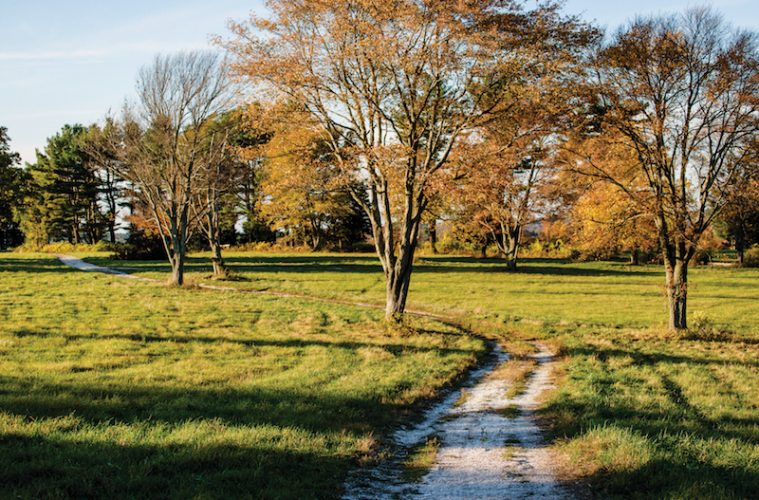Sometimes the most fulfilling paths are those that are accomplished one small step at a time. Consider the one undertaken by the Essex County Greenbelt Association almost 20 years ago, when the land trust spotted several hundred acres of land that were ripe for conservation. Now, the resulting community-based charitable endeavor, the Sagamore Hill Campaign, has come to fruition, after raising $5.1 million to save 525 acres of verdant New England landscape from development.
It was not easy. “It’s a major project, the largest we’ve undertaken,” says Ed Becker, Greenbelt’s president for almost 30 years. His pride in the campaign’s success—a dynamic effort that involved community members, state agencies, and charitable foundations—is palpable. “It was a tremendous effort involving so many people to get this done,” Becker says.
“This project is a great example of a collaborative approach to land protection involving communities, private funders, state agencies, and more than 500 individual donors,” Becker adds. Gifts ranged from $10 to several thousand dollars, and came from all corners of the region.
Greenbelt started studying the acreage, which stretches over Hamilton and Essex, in the 1990s. “It’s land we identified for high-priority conservation because of the nature and character of the land,” Becker says. “The serious conversations started about two years ago.”
In September, the paperwork will be signed and the area will officially open as the Sagamore Hill Conservation Area, which encompasses the 340-acre John J. Donovan Reservation. An additional 185 acres will be permanently protected with a conservation agreement. As a whole, the land creates a crucial conservation corridor with recreational access to Willowdale State Forest, Bradley Palmer State Park, Appleton Farms, Miles River, Manchester-Essex Woods, and the Great Marsh.
The land represents some of the most iconic features of classic New England landscapes: open fields, dense forest, and hedgerows, intersected by meandering stone walls and paths. The highest point of the property reveals expansive views of the Atlantic Ocean. The open hilltop landscape also offers views of the mouth of the Essex River and Cape Ann.
Because the wetlands on the property are the headwaters of the Castle Neck River—which is within the Ipswich River and Essex River watersheds-—the preservation project will benefit the ecological health of the 17,000-acre Great Marsh Ecosystem. The property is also home to the endangered blue-spotted salamander and other species that live in wetland habitats.
But the land also carries the history of early New England life, dating to a time when families grew hay and other crops, kept livestock, and marked their property lines with simple stone walls.
Because most of the land was in small parcels, Greenbelt’s challenges were not limited to just raising cash; logistical feats laced the fundraising effort, which involved a variety of donors. Greenbelt partnered with The Trust for Public Land, a nationwide nonprofit organization, to launch the fundraising. Then residents of Essex and Hamilton authorized contributions totaling $1.8 million through town meeting votes. The Massachusetts state government gave a grant of $1.3 million, and more than 500 individuals contributed a total of $2 million. Charitable institutional giving included a $75,000 grant from the Bafflin Foundation.
Now the land will be open to hikers, runners, nature lovers, bird-watchers, picnickers, equestrians, and cross-country skiers (who may have their own system of Nordic trails eventually). Schools and community groups are enthusiastic about using the preserve.
Greenbelt hopes the property’s agricultural fields will be used again and are considering various proposals. There is also hope that an existing tenant, Black Earth Composting, will continue, reflecting Greenbelt’s commitment to environmental sustainability.
“We were overwhelmed by the public’s enthusiasm for the project, and the wide variety of recreational opportunities the land acquisition could offer,” says Mary Williamson, Greenbelt’s director of development and community engagement. Some of the donations came from residents who said they look forward to a reservation that offers easy accessibility for wheelchairs and wide strollers. As Williamson says, “This kind of wide-road accessibility is not typically available on public hiking trails.”
Chris LaPointe, Greenbelt’s director of land conservation, also played a key role, negotiating with landowners throughout the campaign and working extensively with town and state government funding. The success of the conservation project also has great personal meaning for LaPointe, who lives in Hamilton. “Properties like this, and the amazing scenic resources we are blessed with, are the reason I live here and am raising my family here,” he says. “It was a great gift and a great pleasure to play a part in the protection of a place like this. It’s a treasure for everyone.”
Greenbelt has protected more than 16,000 acres of local land since its founding in 1961. For more information about Greenbelt properties and programs, visit ecga.org or call 978-768-7241.

